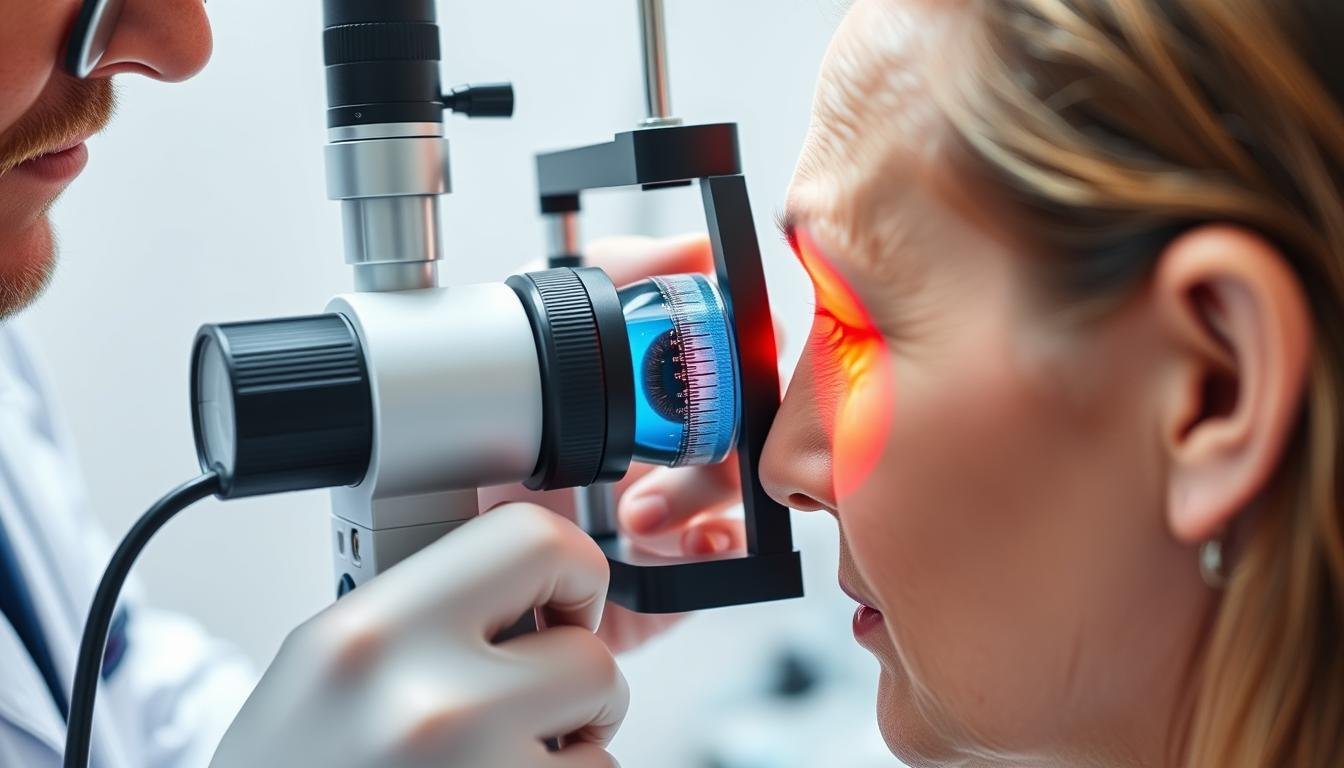When it comes to alternative health practices, few are as visually intriguing as Iridology. This practice suggests that the iris—the colored part of your eye—contains a detailed map of your body’s health. Proponents claim that by examining patterns, colors, and other characteristics in your iris, practitioners can identify health issues before symptoms appear. But how much of this is scientifically supported, and how much remains unproven? This comprehensive guide explores the myths and facts surrounding Iridology, helping you understand what this practice can and cannot tell you about your health.ڇا آهي Iridology and How Does It Work?

هڪ iridologist خاص سامان استعمال ڪندي مريض جي آئرس کي جانچيندي
Iridology is the study of the iris to identify potential health concerns throughout the body. Practitioners believe that each area of the iris corresponds to different organs and body systems. When examining the iris, iridologists look for various markings, colors, and patterns that may indicate inflammation, toxin buildup, or other health issues in corresponding body parts.
جي تاريخ Iridology
جي ابتڙ Iridology are often traced back to Ignaz von Peczely, a Hungarian physician who, in the 1860s, noticed changes in an owl’s iris after the bird suffered a broken leg. This observation led him to develop the theory that changes in the iris could reflect health conditions elsewhere in the body. Von Peczely later created one of the first iris charts mapping different regions of the iris to various body parts.
1950s ۾، آمريڪي chiropractor برنارڊ جينسن وڌيڪ ترقي ڪئي Iridology by creating a more detailed iris chart that is still widely used today. Jensen believed that the iris could reveal not only current health conditions but also hereditary predispositions and past health issues.
Curious About Your Iris?
Download our free guide to learn how to interpret basic iris patterns and what they might reveal about your health.
ڊائون لوڊ مفت icidology گائيڊ
How an Iridology Examination Works



Standard iridology chart mapping iris regions to body systems
During an Iridology session, a practitioner uses specialized tools to examine your iris in detail. These tools typically include:
- Magnifying devices or specialized cameras
- Bright lights to illuminate the iris
- Iris charts for reference and interpretation
- Digital imaging technology (in modern practices)
The iridologist looks for specific signs in your iris, such as:
- رنگ جي تغيرات ۽ رنگن جون تبديليون
- Dark spots or flecks
- White or cloudy areas
- Rings or circles around the iris
- Lines or “spokes” radiating from the pupil
These findings are then compared to an Iridology chart, which divides the iris into approximately 60 zones, each corresponding to different parts of the body. For example, the top section of the iris might represent the brain and head, while the lower sections might correspond to the digestive system or legs.
جي Iridology Chart Explained
هڪ Iridology chart is essentially a map that divides the iris into zones corresponding to different body parts and systems. The left iris is generally associated with the left side of the body, and the right iris with the right side. The chart typically follows a clock-like pattern, with each “hour” position representing different organs or body systems.
Here is more details breakdown organs and systems represented by each eye. These charts serve helpful guide identifye concern based on corresponde Iridology signs.

iridology Chart Left eye (Represents Left Side Body)
| Inidology تي مقام | جسم جو علائقو / عضو مشغول آهي | اهم صحت جا اشارا | ممڪن مسئلا يا عدم توازن |
|---|
| 12 وڳي | Left brain (psychological) | Mental health, emotional state | Stress, anxiety, depression, mental exhaustion |
| 1-2 وڳي | Left face/neck | Skin health, tension in neck muscles | Migraines, neck pain, TMJ disorders, sinus issues |
| 2-3 وڳي | Left throat | Respiratory and throat function | Sore throat, hoarseness, respiratory infections |
| 3-4 وڳي | Left upper back | Spinal health, upper back and shoulder muscles | Upper back tension, shoulder pain, poor posture |
| 4-5 وڳي | Left stomach | Digestive function, acid production | Stomach ulcers, indigestion, low stomach acid |
| 5-6 وڳي | Left pelvic region | Reproductive organs, urinary system | Menstrual issues, urinary tract infections, pelvic pain |
| 6-7 وڳي | Left lower back/legs | Musculoskeletal health, leg circulation | Sciatica, hip problems, lower back pain, leg cramps |
| 7-8 وڳي | Left kidney | Kidney and urinary function | Kidney stones, bladder issues, water retention |
| 8-9 وڳي | Left lungs | Respiratory health, lung capacity | Asthma, chronic bronchitis, shortness breath |
| 9-10 وڳي | Left heart | Cardiovascular system, emotional well-bee | Heart disease, chest pain, circulatory issues |
| 10-11 وڳي | Left digestive organs | Digestive system health | Constipation, bloate, poor digestion, liver function |
| 11-12 وڳي | Left pancreas/spleen | Blood sugar regulation, immune health | Diabetes, hypoglycemia, digestive issues, autoimmune problems |

oridology صحيح اکين جو چارٽ (سا side ي طرف واري جسم جي نمائندگي ڪري ٿو)
| Inidology تي مقام | جسم جو علائقو / عضو مشغول آهي | اهم صحت جا اشارا | ممڪن مسئلا يا عدم توازن |
|---|
| 12 وڳي | صحيح دماغ (نفسياتي) | سنجيدگي واري صحت، ذهني وضاحت | سنجيدگي وارو خاتمو، ذهني ٿڪ، دٻاء |
| 1-2 وڳي | سا face ي منهن / ڳچي | چمڙي جي صحت، سا right ي طرف گردن ۾ تڪرار | جوب جو درد، تڪرار سر درد، سينوس مسئلا |
| 2-3 وڳي | ساڄو رستو | سا lund ڙن lung ڙن، تايرايڊ، ۽ گلا صحت | سورن جي گولي، کنگهه، ڳري، تايراڊ عدم توازن |
| 3-4 وڳي | سا upper و مٿو پوئتي | مٿيون اسپائن، ڪلهي، ۽ l l ڙن جي صحت | ڪلهن، سانس جي مسئلن ۾ تڪرار، مٿو پوئتي درد |
| 4-5 وڳي | ساڀو معاوضو | هضم جا مسئلا، معدي تيز پيداوار | دل جي برن، پيٽ جو السر، بدمعاش |
| 5-6 وڳي | سا pelvic و پيلو علائقو | پيدائش واري عضون، صحيح ٻاراڻي، پيشاب جو نظام | پروسٽٽ مسئلا، حيض جا مسئلا، پيشاب جي پيچيده انفيڪشن |
| 6-7 وڳي | صحيح هيٺين پوئتي / پير | گردش، musculoskelelalalal صحت | اسڪائوٽا، عضلات جا craps ڙا، ٽنگ گردش جا مسئلا |
| 7-8 وڳي | سا kid ي ٻار | گردڪ فنڪشن، فطرتي برقرار رکڻ | گردي جي بيماري، پيشاب جي انفيڪشن، ڊي هائيڊريشن |
| 8-9 وڳي | سا light ڙا l l ڙن | تنفس جي صحت، lung ڙن جي فنڪشن | برونچائٽس، دمه، دائمي رڪاوٽ پطري بيماري |
| 9-10 وڳي | اصل تحہ | دل جي صحت، دل جي فنڪشن | هائپر ٽائونشن، دل جي بيماري، جذباتي دٻاء |
| 10-11 وڳي | صحيح هاضمي عضون | هضم ۽ غذائيت جا جذب | قبض، آئيبس، جگر جا مسئلا، بدمعاش |
| 11-12 وڳي | صحيح پينڪريريا / ڳلي | مدافعتي نظام، رت جي شگر جي ضابطي | ذیابيطس، مدافعتي نظام جي ڪمزوري، هاضمي خرابي |
Top 10 Myths About Iridology Debunked

Modern medical diagnostics compared to iridology examination tools
Despite its popularity in some alternative health circles, Iridology has been surrounded by numerous misconceptions. Let’s examine and clarify some of the most common myths:
افسانو 1: Iridology Can Diagnose Specific Diseases
“Iridology cannot diagnose specific diseases. It can only indicate potential areas of weakness or stress in the body.”
— Dr. Bernard Jensen, considered the father of modern Iridology
حقيقت آهي: Iridology cannot diagnose specific diseases like cancer, diabetes, or heart disease. While practitioners may identify signs of stress or weakness in body systems, these observations cannot replace proper medical diagnosis. Scientific studies have consistently failed to show that iridologists can accurately identify specific diseases through iris examination.
Myth 2: The Iris Changes Regularly to Reflect Current Health Status
حقيقت آهي: The basic structure and pattern of the iris remain relatively stable throughout life. While some subtle changes may occur due to aging or injury, the iris does not continuously change to reflect day-to-day health status. This stability is why iris scans are used for biometric identification—they remain consistent over time.
افسانو 3: Iridology Is an Ancient Medical Practice
حقيقت آهي: While some claim Iridology dates back thousands of years to ancient Egypt or China, modern Iridology as we know it today only emerged in the 19th century with Ignaz von Peczely’s work. There is limited historical evidence of systematic iris analysis before this time.

Ignaz von Peczely, founder of modern iridology (1826-1911)
Myth 4: Iridology Is Scientifically Proven
حقيقت آهي: Most scientific studies have not supported the claims made by Iridology. A 1979 study published in the Journal of the American Medical Association found that iridologists could not accurately detect gallbladder disease through iris examination. Similar studies have shown that iridologists cannot reliably identify conditions like cancer, kidney disease, or other ailments.
Myth 5: All Iridology Practitioners Use the Same System
حقيقت آهي: There are multiple schools of thought within Iridology, each with different approaches and interpretations. Some practitioners follow Bernard Jensen’s system, while others adhere to European methods or more modern approaches. This lack of standardization can lead to different conclusions from different practitioners examining the same iris.
Test Your Iridology Knowledge
Think you understand the basics of iridology? Take our interactive quiz to test your knowledge and learn more about this fascinating practice.
Take Our Iridology Quiz
افسانو 6: Iridology Can Predict Future Health Problems
حقيقت آهي: While some practitioners claim Iridology can predict future health issues, there is no scientific evidence supporting this claim. The iris does not contain information about future health events that have not yet occurred or developed in the body.
Myth 7: Iridology Can Replace Regular Medical Check-ups
حقيقت آهي: Iridology should never replace regular medical check-ups or diagnostic tests. Even practitioners who believe in the value of Iridology typically recommend it as a complementary approach, not a replacement for conventional medical care.
افسانو 8: Iridology Is Completely Harmless
حقيقت آهي: While the examination itself is non-invasive and physically harmless, relying solely on Iridology for health assessments could potentially delay proper medical diagnosis and treatment of serious conditions. This indirect harm is the primary concern of medical professionals regarding Iridology.
Myth 9: Eye Color Changes Indicate Health Changes
حقيقت آهي: Natural eye color is determined by genetics and generally remains stable throughout life. Minor variations in perceived eye color may occur due to lighting, pupil dilation, or surrounding colors, but these do not indicate health changes as claimed by some Iridology practitioners.
Myth 10: A Ring Around the Iris Always Indicates High Blood Pressure
حقيقت آهي: A white or grayish ring around the iris (arcus senilis) is often a normal age-related change caused by lipid deposits. While it can sometimes be associated with high cholesterol in younger people, it is not a reliable indicator of high blood pressure as claimed by some iridologists.

Arcus senilis: A white ring around the iris often mistakenly associated with high blood pressure
Evidence-Based Facts About Iridology
While many claims about Iridology lack scientific support, there are some evidence-based facts worth considering:

Scientific research on iris patterns and their potential health correlations
Fact 1: The Iris Does Contain Unique Biological Information
The iris contains unique patterns that are genetically determined and remain relatively stable throughout life. This uniqueness is why iris scans are used for biometric identification. While this doesn’t validate health diagnosis claims, it does confirm that the iris contains complex biological information.
Fact 2: Some Eye Changes Can Indicate Health Issues
Certain changes in the eye—though not necessarily in the iris—can indicate health problems. For example, yellowing of the whites of the eyes (sclera) can indicate liver problems, and visible blood vessels might suggest hypertension. However, these observations are part of conventional medical examination, not unique to Iridology.
Fact 3: Iridology Examinations Are Non-Invasive
One legitimate advantage of Iridology is that it is completely non-invasive. The examination involves only visual inspection of the iris, with no physical discomfort or risk to the patient.
| Actual Eye Sign | امڪاني صحت جو اشارو | Medical Validity |
| Yellowing of sclera (whites) | Liver issues, jaundice | Medically validated |
| Bulging eyes | Thyroid issues (Graves’ disease) | Medically validated |
| Visible blood vessels | Hypertension, inflammation | Partially validated |
| Arcus senilis (ring around iris) | Age-related change, sometimes high cholesterol | Partially validated |
| Iris color patterns | Organ dysfunction (iridology claim) | سائنسي طور تي تصديق ٿيل نه آهي |
Fact 4: Iridology May Have Psychological Benefits
Some people find value in Iridology consultations because they involve detailed discussions about health and lifestyle. This holistic approach and personal attention may provide psychological benefits, even if the specific iris-based assessments lack scientific validity.
Fact 5: Research on Iridology Is Limited
While most existing studies have not supported Iridology‘s claims, the total body of research is relatively small. Some proponents argue that more research using modern technology and standardized methods might yield different results.

Modern digital iridology analysis using specialized software
Practical Applications of Iridology اڄ
Despite scientific skepticism, Iridology continues to be practiced worldwide. Here’s how it’s commonly applied today:
Complementary Health Assessment
Many practitioners use Iridology as one component of a broader holistic health assessment. Rather than diagnosing specific diseases, they use iris analysis to identify potential areas of weakness that might benefit from lifestyle changes or nutritional support.

Holistic health consultation incorporating iridology findings
Personalized Wellness Plans
Some nutritionists and naturopaths use Iridology as a tool to develop personalized wellness plans. They may recommend specific dietary changes, supplements, or lifestyle modifications based on their interpretation of iris signs.
Educational Tool
Iridology is sometimes used as an educational tool to help people visualize and understand the interconnectedness of body systems. The iris map can serve as a visual reference for discussing how different organs and systems affect overall health.
جديد Iridology Technologies
رواجي Iridology has evolved with technology. Modern practitioners often use digital cameras and specialized software to capture and analyze iris images, allowing for more detailed examination and record-keeping.
Expand Your Knowledge
Join our upcoming webinar where experts discuss the historical development of iridology and its place in modern complementary medicine.
Register for Iridology Webinar
Limitations of Iridology in Practice
Even practitioners who value Iridology acknowledge its limitations:
امڪاني فائدا
- غير جارحتي تشخيص
- May identify areas of constitutional weakness
- Can encourage preventive health measures
- Provides a holistic perspective
- May complement other health assessments
Recognized Limitations
- Cannot diagnose specific diseases
- Lacks scientific validation
- Interpretations vary between practitioners
- Should not replace medical diagnosis
- May lead to unnecessary treatments

Discussing iridology findings with a conventional medical doctor
اڪثر پڇيل سوال بابت Iridology
Is Iridology scientifically proven?
نه، Iridology is not scientifically proven. Most scientific studies have failed to demonstrate that iridologists can accurately diagnose health conditions through iris examination. A notable study published in the Journal of the American Medical Association found that iridologists could not detect gallbladder disease from photographs of irises. However, research in this field is limited, and some practitioners argue that more studies using standardized methods are needed.
Can Iridology detect cancer?
There is no scientific evidence that Iridology can detect cancer. A study published in the Journal of Cancer Research and Clinical Oncology found that iridologists could not reliably identify patients with cancer by examining their irises. Medical professionals strongly advise against using Iridology as a cancer screening tool and recommend conventional medical screening methods instead.
How much does an Iridology session cost?
هڪ جي قيمت Iridology session varies widely depending on location, practitioner experience, and session length. Typically, sessions range from to 0. Some practitioners include Iridology as part of a broader naturopathic or holistic health consultation, which may affect the overall cost.
Can Iridology help with preventive healthcare?
Proponents suggest that Iridology may help identify areas of weakness before symptoms develop, potentially allowing for preventive measures. However, there is limited scientific evidence supporting this claim. If you’re interested in preventive healthcare, consider evidence-based approaches such as regular medical check-ups, healthy diet, regular exercise, and stress management alongside any complementary approaches.
Do iris patterns change with health conditions?
The fundamental structure and pattern of the iris remain relatively stable throughout life. While Iridology practitioners claim to observe changes that correspond to health conditions, scientific evidence does not support the notion that the iris regularly changes to reflect health status. Some visible changes in the eye (though not necessarily the iris) can indicate health issues, but these are generally recognized by conventional medicine as well.

Various iris patterns and colors studied in iridology
The Bottom Line on Iridology

Making informed decisions about incorporating iridology into health practices
Iridology remains a controversial practice in the health world. While scientific evidence does not currently support many of its claims, some people find value in its holistic approach to health assessment. If you’re interested in exploring Iridology, consider these balanced recommendations:
- Approach Iridology as a complementary tool, not a replacement for conventional medical care
- Consult with qualified healthcare providers for any health concerns
- Be skeptical of practitioners who claim to diagnose specific diseases through iris examination alone
- Consider the psychological and holistic benefits that might come from the process, regardless of the specific iris analysis
- Stay informed about both traditional and complementary approaches to health
Whether you view Iridology as a fascinating alternative perspective or remain skeptical of its claims, understanding both the myths and facts can help you make informed decisions about your health care approach. The eyes may indeed be windows to many things—but the extent to which they reveal our health remains a subject of ongoing debate.















